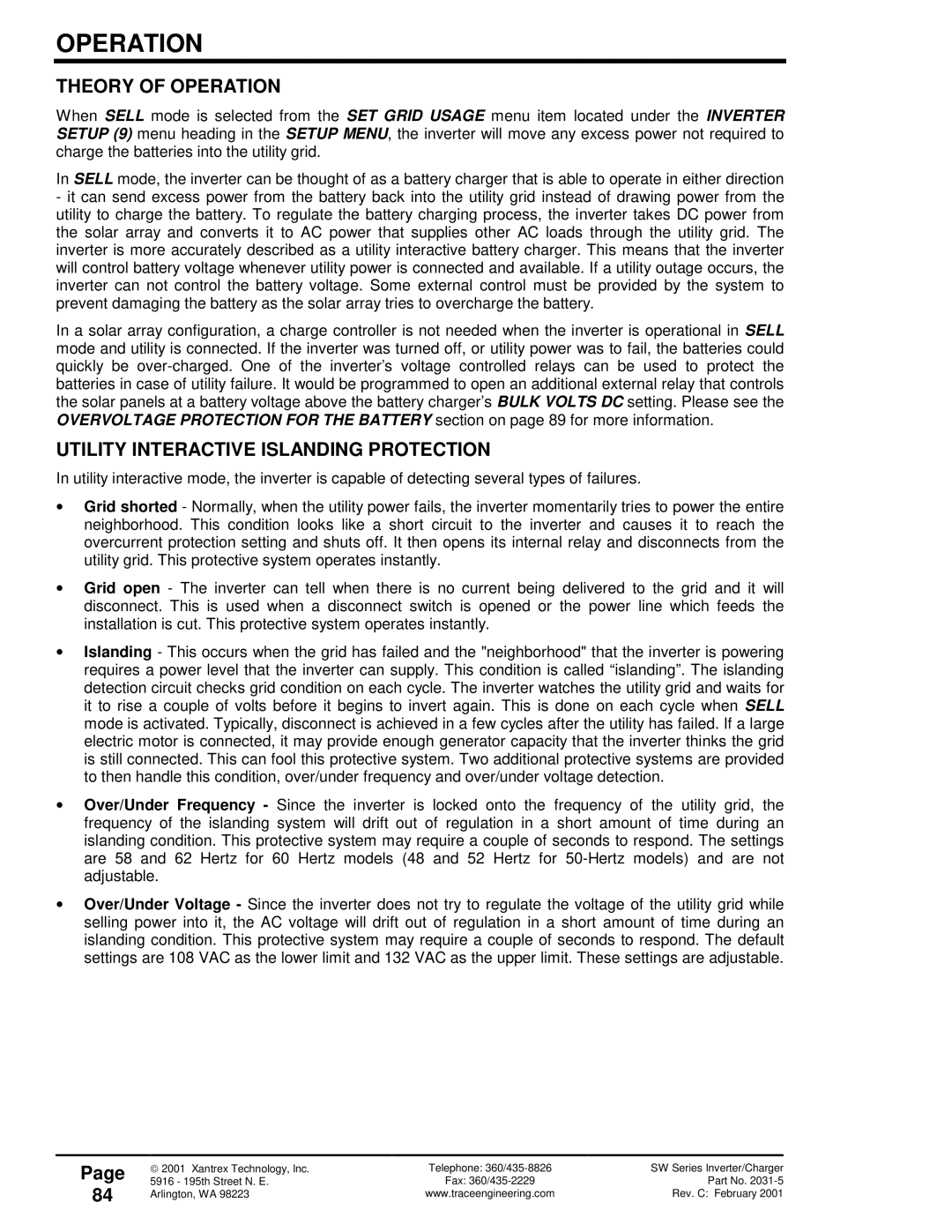
OPERATION
THEORY OF OPERATION
When SELL mode is selected from the SET GRID USAGE menu item located under the INVERTER SETUP (9) menu heading in the SETUP MENU, the inverter will move any excess power not required to charge the batteries into the utility grid.
In SELL mode, the inverter can be thought of as a battery charger that is able to operate in either direction
-it can send excess power from the battery back into the utility grid instead of drawing power from the utility to charge the battery. To regulate the battery charging process, the inverter takes DC power from the solar array and converts it to AC power that supplies other AC loads through the utility grid. The inverter is more accurately described as a utility interactive battery charger. This means that the inverter will control battery voltage whenever utility power is connected and available. If a utility outage occurs, the inverter can not control the battery voltage. Some external control must be provided by the system to prevent damaging the battery as the solar array tries to overcharge the battery.
In a solar array configuration, a charge controller is not needed when the inverter is operational in SELL mode and utility is connected. If the inverter was turned off, or utility power was to fail, the batteries could quickly be
UTILITY INTERACTIVE ISLANDING PROTECTION
In utility interactive mode, the inverter is capable of detecting several types of failures.
•Grid shorted - Normally, when the utility power fails, the inverter momentarily tries to power the entire neighborhood. This condition looks like a short circuit to the inverter and causes it to reach the overcurrent protection setting and shuts off. It then opens its internal relay and disconnects from the utility grid. This protective system operates instantly.
•Grid open - The inverter can tell when there is no current being delivered to the grid and it will disconnect. This is used when a disconnect switch is opened or the power line which feeds the installation is cut. This protective system operates instantly.
•Islanding - This occurs when the grid has failed and the "neighborhood" that the inverter is powering requires a power level that the inverter can supply. This condition is called “islanding”. The islanding detection circuit checks grid condition on each cycle. The inverter watches the utility grid and waits for it to rise a couple of volts before it begins to invert again. This is done on each cycle when SELL mode is activated. Typically, disconnect is achieved in a few cycles after the utility has failed. If a large electric motor is connected, it may provide enough generator capacity that the inverter thinks the grid is still connected. This can fool this protective system. Two additional protective systems are provided to then handle this condition, over/under frequency and over/under voltage detection.
•Over/Under Frequency - Since the inverter is locked onto the frequency of the utility grid, the frequency of the islanding system will drift out of regulation in a short amount of time during an islanding condition. This protective system may require a couple of seconds to respond. The settings are 58 and 62 Hertz for 60 Hertz models (48 and 52 Hertz for
•Over/Under Voltage - Since the inverter does not try to regulate the voltage of the utility grid while selling power into it, the AC voltage will drift out of regulation in a short amount of time during an islanding condition. This protective system may require a couple of seconds to respond. The default settings are 108 VAC as the lower limit and 132 VAC as the upper limit. These settings are adjustable.
Page
84
2001 Xantrex Technology, Inc. | Telephone: | SW Series Inverter/Charger |
5916 - 195th Street N. E. | Fax: | Part No. |
Arlington, WA 98223 | www.traceengineering.com | Rev. C: February 2001 |
